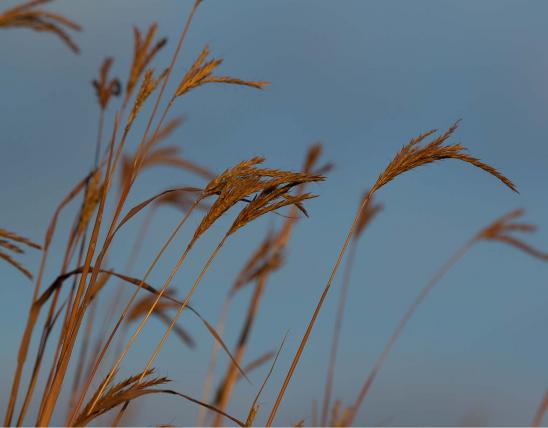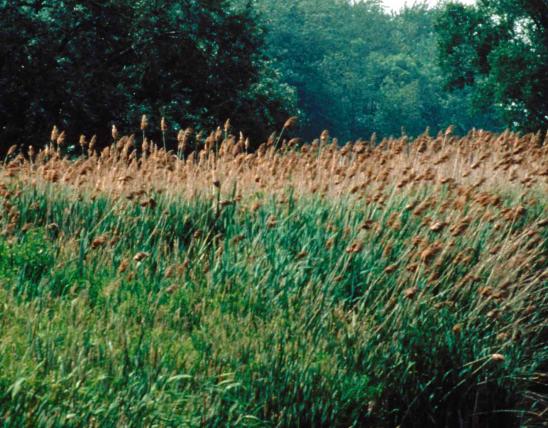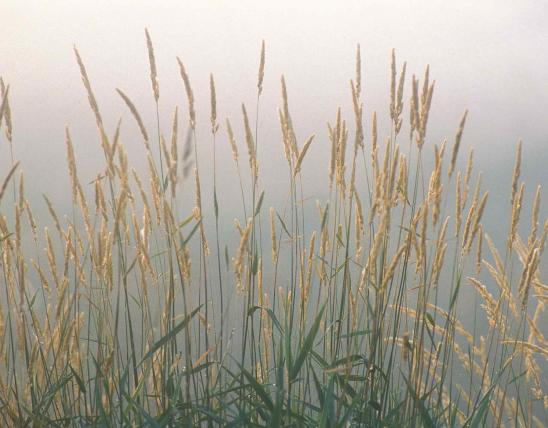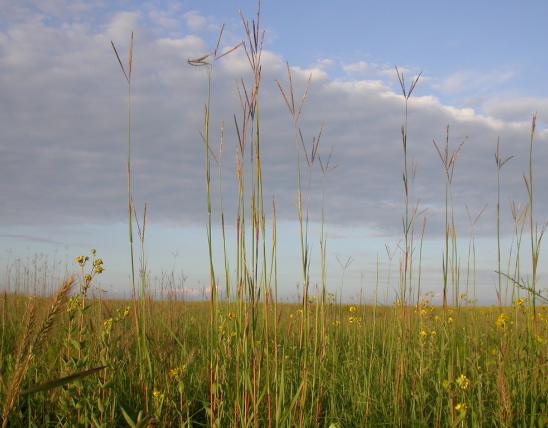
Giant cane is Missouri’s native species of bamboo. It is scattered, mostly in our southernmost counties and the Bootheel. In its low, moist habitats, it sometimes forms canebrakes — dense, nearly pure thickets. It is Missouri’s only native grass that is woody by nature and thus can be considered a shrub.
The stalks, literally bamboo canes, are woody, branched above, and rarely more than 16 feet tall. It grows in dense colonies due to vegetative spread by rhizomes (branching rootstocks).
The leaves are somewhat crowded at the ends of the branches; the blades are grasslike with parallel veins; 4–12 inches long, to about 1¼ inches wide; longer than broad and lance-shaped to long and narrow; the tip is pointed; the base is rounded or tapering, enclosing the stem; the margins with small, sharp teeth.
The stems are woody, perennial, smooth, with hollow segments between the nodes separated by the solid nodes; green, turning light brown with age. At maturity, stems are well branched with side branches that are smaller than the main stems. New growth in spring develops at the nodes of existing stems, as well as from the rhizomes at the base.
Flowers are purplish and rare. They occur in loose clusters composed of larger, flattened flower stalks from branches on old wood. The flower stalks are 1½– 2½ inches long, mostly with 5–15 flowers, lacking petals. Blooms April–May, but flowering is uncommon and sporadic in Missouri, especially when plants grow in dense shade. This species is propagated mostly by rhizome fragments that are transported by water.
Fruits are furrowed grains, enclosed in flattened spikelets. Not commonly observed in Missouri.
Similar species: Giant cane is sometimes confused with giant reed (Arundo donax), which is not a true bamboo and is not native to Missouri. Giant reed is uncommon and widely scattered in Missouri, usually growing in open, disturbed areas; it is cultivated as an ornamental and sometimes escapes. It can form large, dense colonies but does not appear to be invasive in natural communities in Missouri (though it has been declared invasive in other states). You can distinguish giant reed by its generally annual, few-branched stems, and although its leaf blades are somewhat “eared” at the base, they are not abruptly narrowed and jointed to the tip of the sheath.
Three genera of nonnative bamboos are cultivated as ornamentals in Missouri and can potentially become established outside cultivation from rootstock fragments discarded or dispersed by human activities, particularly in and around urban areas. These genera include Phyllostachys, Pseudosasa, and Sasa. Phyllostachys has stems with a flattened areas on 1 side above each node. Pseudosasa and Sasa both have only 1, or maybe 2 (not usually several) per node on the main stems. Common names for these Asian species are many and varied: running bamboo, fishpole bamboo, golden bamboo, yellow grove bamboo, arrow bamboo, broadleaf bamboo, and so on. Several states consider one or more of these nonnative species to be invasive.
Height: typically 5–10 feet; rarely more than 16 feet; sometimes to 25 feet in states with warmer winters (along the Gulf Coast from Texas to North Carolina and south).
Scattered in the southern portion of the Ozarks and in the Bootheel lowlands, north to Ste. Genevieve County. Occasionally it is planted farther north.
Habitat and Conservation
Occurs in bottomland forests, banks of streams and rivers, margins of lakes, and along the base of dolomite bluffs. This species often forms “canebrakes,” which are dense, nearly pure (monocultural) stands or thickets.
Giant cane once was far more common and widespread in Missouri than it is today, and large acreages were once covered by canebrakes. Plants apparently used to occur naturally at least as far north as Franklin County, where a valley in Meramec State Park is known as Cane Bottoms. The extensive canebrakes of southern Missouri were eliminated or reduced by a number of habitat changes, including damming and channeling of rivers, siltation of stream and river floodplains, grazing and trampling by livestock, conversion of land to agriculture, urbanization, and in some cases apparently the closing in of forests following fire suppression.
Status
Native Missouri grass. Because it is tall, woody, and forms dense thickets, it can be considered a shrub.
Globally, there are about 10,000 species in more than 600 genera in the grass family (Poaceae). To help organize this large family, botanists have divided it into tribes (basically subfamilies). Tribes are groups of genera that share a common evolutionary lineage and characteristics. Missouri has about 275 grass species representing 17 tribes. Giant cane is Missouri’s only native member of the bamboo tribe (Bambuseae). Globally, there are about 850 species, in 50 genera, in the bamboo tribe.
Human Connections
Giant cane is sometimes planted north of its natural range, but it will be killed back to the ground during cold winters. It spreads by its rhizomes and can become invasive in a home landscape. To keep it contained and prevent uncontrolled spreading, you will need to build a barrier in the soil or else grow the plants in large plastic pots dug into the soil. A dense stand of giant cane can make an effective, dense screen, border, or background. It can be used to prevent erosion. It can be used as a hedge or in rain gardens, and it looks interesting in winter.
Native Americans and early European settlers used the seed of giant cane for food. The young shoots were used as a potherb in the same manner as the bamboo shoots of tropical countries.
The young shoots and leaves furnish forage for livestock.
The sturdy stems and leaves of giant cane have been used to make baskets, mats, pipe stems, fishing poles, and other craft items. The Cherokee, whose homeland includes the historic range of giant cane, use it in their basketry. Historically, they kept stands of giant cane healthy and productive by judicious cutting and periodic burning. In addition to basketry, they and other southeastern tribes used giant cane to make medicine, spears and arrows, bows, knives, blowguns, flutes, traps for fish, and more.
The word “caney” comes up pretty often in southern Missouri place-names, such as Caney Creek, in Scott County, and Caney Mountain, in Ozark County. The “-ey” or “-y” suffix for adjectives is an antique one that endured from settlers who had moved to the Ozarks from Appalachia. Today, it would probably be named “Cane Creek” or “Cane Mountain.” You see this construction in other place-names such as the Piney River, which today would’ve been named Pine River. Other old-time Ozark adjectives like this include gladey (rocky, barren), ledgey (uneven, like a road over steplike bedrock), resty (lazy), withey (wiry, tough, like a hickory withe), and yieldy (fertile, productive, such as land). Linguists point out that Ozark and Appalachian dialects contain many remnants of Elizabethan English, survivals from America’s early English settlers.
For more on the fascinating history of Missouri’s native bamboo, see the article by A. J. Hendershott, “Canebrakes: Missouri’s Bamboo Forests,” in the October 2002 issue of Missouri Conservationist.
Ecosystem Connections
Giant cane is one of the most distinctive plants in mesic bottomland woodlands in the Current River, White River, and Black River portions of the Ozarks, and in the Mississippi Alluvial Plain. Associated plants include bur oak, swamp white oak, pecan, black snakeroot, river oats, purple coneflower, goldenglow, American beakgrain, and round-leaved groundsel.
Giant cane used to grow in large colonies across much of the southeastern United States, but today, many of the natural communities it used to live in have been destroyed.
Two of Missouri’s woodland butterflies are restricted to moist woodlands with canebrakes in the southern part of the state: the southern pearly-eye and the Creole pearly-eye. They use giant cane as their caterpillar food plant.
The young shoots of giant cane were an important forage for the woodland bison, elk, and black bears that used to be common in Missouri’s Ozarks.
Many species are closely associated with giant cane and the rich bottomland forests of Missouri’s southern Ozarks. Hooded and Swainson’s warblers are great examples. Swainson’s warbler is a rare summer resident that prefers canebrakes for its nesting habitat. They are usually seen foraging on the ground under canebrakes for insects under leaves and in the ground litter. The Missouri range of Swainson’s warbler matches the range of giant cane in our state. Hooded warblers also nest in this habitat, though they also nest locally in densely vegetated habitats on moist north- and east-facing slopes farther north in our state. These rare summer residents are often seen as they fly out to capture flying insects on the wing, but they are very difficult to see in dense foliage.
Across the southeastern United States, the Kentucky warbler and white-eyed vireo are also associated with canebrake habitats. The Bachman’s warbler — now likely extinct — also needed canebrakes, relying on them for nesting habitat.
The decline of canebrake habitat on our continent was related to overgrazing by livestock, fire suppression (since cane is a fire-adapted species that cannot survive for long if shaded out by larger trees), and land being converted to agriculture or other human development.






























